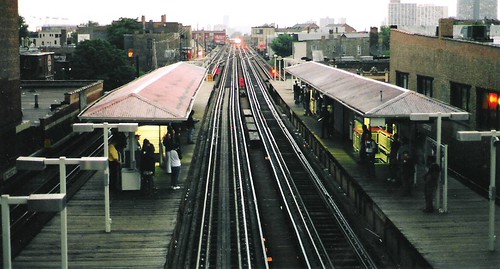
The battle between benches and bucket seats is raging in Chicago. (Graphic via Chicago Tribune)
The MTA’s current rolling stock is quite a mess of seating choices. We have trains that feature bucket seats far too narrow and center-facing seats to maximize standing room. We have trains with forward-facing bucket seats that lead to awkward passenger flow and cramped quarters. And we have all of our bright and shiny new rolling stock with center-facing benches that should, ostensibly, cram more people into the train cars while creating a more comfortable experience.
None of it works entirely properly. No matter which way the seats are oriented, Transit’s bucket seats — like bucket seats around the nation — are too narrow. In the winter, anyone with a warm coats winds up taking up too much space, and even the skinniest of riders will find themselves contained by the dip. Meanwhile, oftentimes, straphangers will either sit on top of each other or leave three quarters of an empty seat just sitting there. The forward-facing bucket seats on the R68s encourage riders to congregate around doorways, and riders on the bench seats — the best of three layouts — tend to take up more room than they should.
For New York City, though, the future is in benches. While a full R68 set has 560 seats and a full R142 set contains around 432 seats, the R142s fit far more standees, and thus, center-facing buckets rule the day. For the foreseeable future, all new rolling stock orders will be equipped with those grey-blue benches, and the forward facing cars, with their views out the window, will become relics.
Around the nation, though, consensus has not be quite as easy to reach. The Metro down in DC still has forward-facing seats, and trains quickly fill up at rush hour as passenger flow crawls to a stop. Now, Chicago is debating its approach to passenger seating. Calling the CTA’s latest iteration of buckets “New York-style seating,” Jon Hilkevitch of The Chicago Tribune opined on the right approach:
The center-facing scoop seat on the CTA’s new 5000 Series rail car, a departure from the forward-facing seats on the CTA’s older railcars, is only 17.5 inches wide. The design assumes 17.5 inches is a comfortable seat width for everyone. But if the “average-sized rider” is bookended by two larger passengers who are spilling over their allotted seat space, the poor commuter in the middle feels like a ham sandwich in a George Foreman Grill.
Benches, on the other hand, allow for some latitude and help each passenger have a little personal space.”We only have a few cars with scoop seating. Our R142 cars (delivered in the early 2000s) are bench-style and the new R179 cars that we ordered this year will have benches,” [New York City Transit Charles] Seaton said…
CTA riders who have ridden on the MTA cars know that the 5000 Series cars are not New York-style, despite the center-facing seat format. “CTA cars are nothing like New York cars,” said CTA rider Colman Buchbinder. He noted that the aisles are wider on the MTA fleet, “allowing a feeling of space,” and the grab poles are located in the middle of the aisle, instead of being wedged between the seat dividers on the CTA cars.
As for the bench design, “Big people take up big spaces and small people take up small spaces. That’s a huge difference from Chicago’s setup of narrow individual bucket seat forms that force people to squeeze or leave an empty seat,” Buchbinder said. “If you think it’s bad now, wait until winter when the coats come on.”
Chicago, it seems, has irked its customers by providing bucket seats too narrow for those who secure a seat, and aisles too narrow for passengers trying to make their ways through the cars. It’s a classic example of how seat and car design can impact subway mobility and rider happiness. While we all want to aspire to a seat, the reality is that most people in a packed subway will not be seating, and then, making sure straphangers can enter and exit quickly and easily becomes a paramount concern.
Ultimately, I think we’ll see center-facing benches become the norm, but it’s a slow adjustment. DC and Chicago aren’t quite there yet, and even international subway systems that can be a bit more progressive with their policies are finding it tough to let go of the forward-facing seats. A subway though isn’t a commuter rail, and I’ll give the last word tonight on benches to a CTA rider. “Smooth benches allow for a seating free-market of sorts, where wide and narrow find their own equilibrium,” James Jenkins added. “The molded forms don’t allow for that nirvana.”

 The MTA has frequently come under fire for its real estate holdings. Politicians and advocates believe that the authority doesn’t make proper use of the space it both rents and owns, and underground, commercial opportunities are decidedly low rent. It is a problem the MTA is trying to solve in order to generate more money.
The MTA has frequently come under fire for its real estate holdings. Politicians and advocates believe that the authority doesn’t make proper use of the space it both rents and owns, and underground, commercial opportunities are decidedly low rent. It is a problem the MTA is trying to solve in order to generate more money. 
